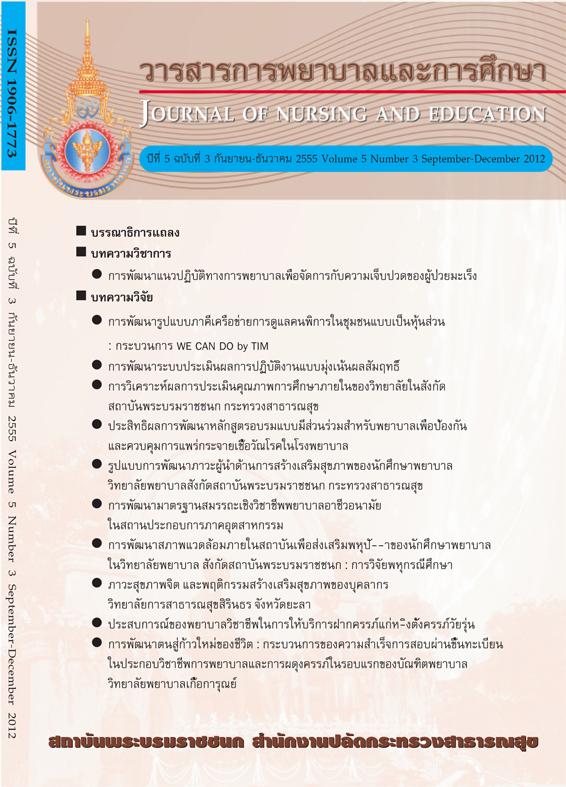การพัฒนารูปแบบภาคีเครือข่ายการดูแลคนพิการในชุมชนแบบเป็นหุ้นส่วน : กระบวนการ WE CAN DO by TIM
คำสำคัญ:
Partnership networking model, People with physical disability, Participatory community – based action research, Caring for people with disability in the communityบทคัดย่อ
บทคัดย่อ
การวิจัยครั้งนี้เป็นการวิจัยเชิงปฏิบัติการแบบมีส่วนร่วมโดยใช้ชุมชนเป็นฐาน มีวัตถุประสงค์ เพื่อศึกษากระบวนการและผลการพัฒนารูปแบบภาคีเครือข่ายการดูแลคนพิการในชุมชนแบบเป็นหุ้นส่วน โดยศึกษาในกลุ่มตัวอย่าง ที่เลือกแบบเจาะจงประกอบด้วย คนพิการกับญาติผู้ดูแล จำนวน 25 คู่ และบุคลากร ที่เกี่ยวข้องกับการการให้บริการด้านคนพิการ ได้แก่ พยาบาลชุมชน 3 คน นักกายภาพบำบัด 1 คน ผู้นำชุมชน 5 คนและ อาสาสมัครประจำหมู่บ้าน 6 คน เจ้าหน้าที่องค์การปกครองส่วนท้องถิ่น จำนวน 2 คน ประชาชนที่ เป็นจิตอาสา 10 คน ดำเนินการวิจัยเป็น 2 ระยะคือ ระยะที่ 1 เป็นระยะของการสร้างรูปแบบการดูแลคนพิการ ในชุมชนเบื้องต้น ระยะที่ 2 เป็นระยะพัฒนารูปแบบภาคีเครือข่าย การดูแลคนพิการในชุมชนแบบเป็น หุ้นส่วน การเก็บรวบรวมข้อมูลใช้ วิธีการสนทนากลุ่ม การสัมภาษณ์เชิงลึก การสังเกตแบบมีส่วนร่วมและ แบบไม่มีส่วนร่วม วิเคราะห์ข้อมูล โดยใช้สถิติเชิงพรรณนาและวิธีการวิเคราะห์เชิงเนื้อหา
ผลการศึกษา ได้รูปแบบภาคีเครือข่ายการดูแลคนพิการในชุมชนแบบเป็นหุ้นส่วนที่เป็นรูปธรรม มีข้อค้นพบที่สำคัญคือ กระบวนการ WE CAN DO by TIM ที่ใช้ในการพัฒนาเครือข่าย ประกอบด้วย
7 ขั้นตอน 3 คุณลักษณะ คือ 1) การสร้างความตั้งใจ มุ่งมั่น และความร่วมมือในการดูแลคนพิการ
(W-Willing) 2) การร่วมค้นหา มองและสะท้อนปัญหา ความต้องการ (E-Exploration) 3) การรวมพลังร่วมคิด เพื่อการพัฒนา (C-Cognition) 4) การร่วมปฏิบัติตามรูปแบบการดูแลที่พึงประสงค์ (A-Acting) 5) การร่วมประเมินและให้ข้อสังเกตการปฏิบัติ (N-Notice) 6) การร่วมแสวงหาและพัฒนาต่อ (D-Decoration) และ 7 ) การสร้างความโดดเด่น ความต่อเนื่องและ ความยั่งยืนด้วยการเพิ่มพลัง (O-outstanding) โดยภาคีเครือข่าย จะมีคุณลักษณะเด่น 3 คุณลักษณะ คือ 1) ทำงานเป็นทีมที่ชัดเจน (T-Team approach) 2) มีแรงบันดาลใจในการดูแลคนพิการ (I-Inspiration) และ 3) มีความรู้สึกร่วมในการทำเพื่อมวลมนุษยชาติ (M-Mankind) สำหรับผลการพัฒนารูปแบบครั้งนี้พบว่าคนพิการมีคุณภาพชีวิตดีขึ้น ญาติผู้ดูแลรู้สึกเป็นภาระ ในการดูแลน้อยลง ภาคีเครือข่ายมีการรับรู้พลังอำนาจและมีความเข้มแข็ง ในการทำงานของกลุ่มเพิ่มขึ้น
ข้อเสนอแนะจากการศึกษาพบว่ากระบวนการ WE CAN DO by TIM เป็นกลวิธีที่สำคัญ ในการสร้างความเป็นหุ้นส่วนของภาคีเครือข่ายในการดูแลคนพิการในชุมชน ซึ่งเป็นกิจกรรมที่
พยาบาลชุมชนและบุคลากร ด้านสุขภาพสามารถที่จะนำไปประยุกต์ใช้เพื่อทำให้เกิดผลลัพธ์ที่ดีในการ ดูแลคนพิการ
คำสำคัญ : รูปแบบการสร้างภาคีเครือข่าย คนพิการทางกายและการเคลื่อนไหว
การดูแลคนพิการในชุมชน การวิจัยเชิงปฏิบัติการแบบมีส่วนร่วม
Abstract
The purposes of this study, the participatory community – based action research, were to explore the process and the effects of partnership networking development for caring people with physical
disability in the community. Twenty-five pairs of people with physical disability and family caregivers, three community nurses, one physiotherapist, five community leaders, six community leaders, two local authority officers, and ten village health volunteers were selected by purposive sampling to participate in the study. The research process composed of 2 phases including 1) establishment of initial networking for caring people with physical disability model and 2) development of partnership networking model. Focus group, in-depth interview, participatory and non-participatory observation methods were used to collect the data. Descriptive statistics and content analysis method were performed to analyze the data.
The findings of the study revealed that the “ WE CAN DO by TIM” was the significant process influencing on successful partnership networking for caring people with physical disability model
development. This process composed of 7 stages: 1) W: creating of networking members’ willingness, 2).E: co-exploring situation needs and problems, 3). C: sharing ideas for development, 4). A: acting
together following the model, 5) N: co-evaluating and exploring the notices, 6) D: co-seeking and decorating the model, and 7) O: creating outstanding unique of the model and continuing for sustainability. In addition, networking members’ characteristics were 1) T: effective team approach, 2) I: networking members’ inspiration, and 3) M: acting goal for mankind. The partnership networking for caring people with physical disability model development affected 1) people with physical disability on increasing quality of life, 2) caregivers on perceiving less burden and enhancing empowerment, and members of network on perceived high empowerment and strengthening networking system.
The findings suggest that the” WE CAN DO by TIM” process is essential strategy to establish the partnership networking for caring people with disability in the community. Furthermore, this model may be a beneficial intervention for community nurses and health teams to apply in practice in order to provide a greater impact on enhancing positive care outcomes for people with disability at home.
Keywords : Partnership networking model, People with physical disability, Participatory community – based action research, Caring for people with disability in the community






